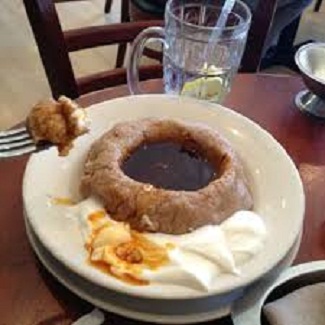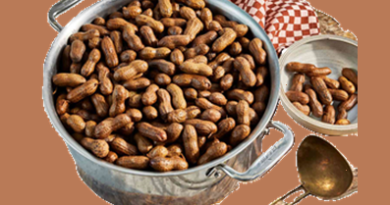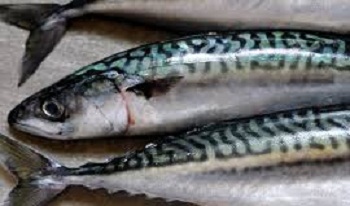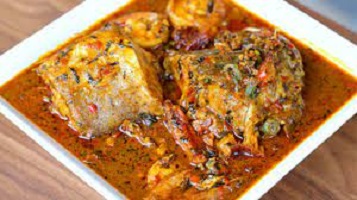Genfo / Ga’at: Ethiopia & Eritrea Breakfast Porridge
Genfo is the Amharic name for a thick porridge eaten for breakfast in Ethiopia and Eritrea, where it is known as ga’at.
To anyone not conversant with Ethiopian restaurants, genfo’s appearance may come as a surprise.
The solitary mound of dough in a bowl does not match the formula of stew on spongy flatbread (It reminds so much of Nigerian Agoyin sauce and Ewa)
The most typical version of this cultural dish is made with barley flour, although it is recreated in the diaspora using wheat and occasionally cornmeal.
Genfo is prepared by adding dry-roasted barley flour to boiling water and stirring the concoction with a wooden spoon until it develops a smooth, yet extremely thick consistency.
The resulting porridge which is stiff and slightly sticky when warm is then transferred to a bowl, and a hole is created in the center, usually by using a finjal (Ethiopian coffee cup).
The final step is to fill the well with niter kibbeh (tesmi in Eritrea), spiced butter, and the red-pepper-and-spice blend called berbere.
This East African traditional food bears a strong resemblance to Asida. Another stiff, flour-based porridge is served with a sauce in its center.
Asida is commonly eaten in Arab and North African countries, especially for the holidays.
Both are by tradition consumed like that or flanked by scoops of yogurt which balances the flavors.
Like other Ethiopian dishes, this porridge is often shared and consumed with the hands or with a utensil.
The method is by pulling the thick porridge pieces from the outside and dipping them into the spice blend in the center.
Nutritional Value & Potential Benefits of Genfo
- Warm with a nice aroma, this healthy dish will help a nursing mother gain back her strength and recover quickly.
- The flour which makes up the bulk of this recipe provides lots of carbohydrates for energy.
- Butter/oil – provide fats, which are important for storing energy and absorbing fat-soluble vitamins.
- Finally, Berbere – is a blend of various spices with multiple nutritious compounds. Such as, chili peppers are rich in vitamins A and C, and fenugreek is rich in vitamin B2 (riboflavin), iron, and copper
Genfo Ethiopian Food Recipe – Homemade
Take a deeper look at this simple dish to discover the results of the geography, history, and evolution of a region.
Ingredients
- Wheat and bula flour
- Salt
- One teaspoon berbere
- 1 tablespoon kibe
- Water 1 liter
Method
- Firstly, add the wheat flour to a dry pan and slowly dry roast for 3-5 minutes.
- Secondly, boil enough water in a large pan, remove about 250 ml of the boiling water and put it aside.
- Thirdly, carefully and slowly add water and then add the toasted wheat flour to the large pan and start mixing, keep the heat low and keep mixing.
- Fourthly, add a little of the remaining boiled water, keep the lid on and cook for about 30 minutes. Keep an eye on it and stir often.
- After that, add bula flour and a little cold water to a small bowl and mix.
- Then add the bula paste to the pan and mix in, keep turning and cooking for 15 minutes. Add salt.
- Next, add the genfo to a serving bowl and make a well in the center.
- Lastly, melt the butter and pour it into the well, then add the berbere together with the butter and mix.
Serve plain or flanked by scoops of yogurt.

FAQs
What does Genfo mean in English?
Genfo is the Amharic name for ga’at, a thick porridge eaten for breakfast in Ethiopia and Eritrea.
The most common version is made with barley flour, but it is also made with wheat and occasionally corn meal in the diaspora.
Who created Genfo?
Genfo is presented in the form of a large mound with a central hole filled with a mixture of niter kibbeh and berbere.
How is Genfo flour made?
- Firstly, boil the water, then reduce the heat and gradually add the flour mixture, stirring constantly to avoid lumps.
- Continue to stir until the mixture is thoroughly moistened.
- After that, remove from the heat and place the Genfo in a large enough bowl, then make a hole in the center.
GAAT? Recipe ~ How to Make Gaat, an Eritrean Breakfast
- Firstly, boil the Water. Boil hot water, then, save some water on the side, in case the dough gets too thick
- Secondly, add Salt and Thine, then Melt the Tesmi
- Thirdly, shape the Dough and add Ingredients to the Hole
- Lastly, enjoy
What exactly is Ethiopian kocho?
Kocho (Ge’ez:,) is a fermented bread made from chopped and grated ensete pulp. It is a staple in Ethiopian cuisine, replacing injera.
In 1975, more than one-sixth of Ethiopians relied entirely or partially on kocho for a significant portion of their food.
What foods does Eritrea eat?
Tsebhi (stew) is the main traditional food in Eritrean cuisine, served with injera (flatbread made from teff, wheat, or sorghum and hilbet) (a paste made from legumes; mainly lentil and faba beans).
Is fufu consumed in Ethiopia?
Fuul. Ethiopian fuul is a stewed and spiced fava bean dish popular in East Africa and the Middle East that many Ethiopians eat for breakfast.


